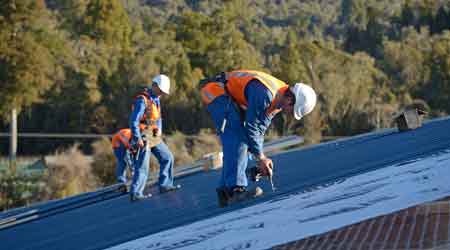When is The Time to Repair, Replace or Restore a Roof?
Effective roof management requires an understanding of system conditions and long-term facility plans
Using the roof system’s age, evaluation data and the RCI rating, managers can determine the best course of action for a roof — repair, replace, or restore.
Managers should consider repairs and maintenance on roofs they determine are in fair to excellent condition — a 50-100 RCI rating. These roofs still have good life cycle remaining, and it makes financial and operational sense to continue investing in them.
These roofs also should be on a preventive maintenance program that consists of semi-annual inspections with the needed repairs being completed simultaneously. If leaks arise, managers should engage a qualified contractor to perform repairs to restore the roof’s watertight condition.
Managers should consider replacement of roofs they determine are in failed to poor condition — a 0-30 RCI rating. Maintenance and repairs will be ineffective on these roofs, so technicians should only take such steps in an emergency until a full replacement can take place.
Roof restoration is an often forgotten about but highly impactful third option. When completed properly, it can double the life of the existing roof for about one-quarter of the cost of a full replacement. Unfortunately, restoration is a highly misunderstood practice that is often incorrectly executed.
Managers should consider restoration of roofs that have an RCI of 50-70 and are at a midpoint in their life expectancy. Restoration is done by repairing defects and providing a new coating, which restores the weatherproofing integrity of the roof. The critical component in the process is making all required repairs and having a roof with sound construction to start with before the coating.
Once managers decide on a course of action, it is important to review the pros and cons of each roof type and prepare a specification that aligns with the organization’s objectives to get the best return on investment. Managers should not install a BUR system with a 30-year life expectancy on a facility the organization expects to keep for only 15 years.
Conversely, if facility executives plan to remain in a building for the long term, it makes sense to invest heavily up front in a high-quality system and get the lowest overall life-cycle cost of ownership. Managers also need to consider facility use.
Manufacturing facilities might need a more redundant roof type — a BUR or modified bitumen system — while an administrative building might be better off with a single-ply system. Roof management is challenging. At some point, water enters every building. How managers react and mitigate risk makes the biggest impact. A strong preventive maintenance program will go a long way in extending the life of existing roofs and mitigate risk of costly, disruptive leaks. Armed with this base knowledge of roof system technology, steps to assess roof conditions, and insights into selecting the best option for remediating, managers will be better equipped to make a savvy long-term decision.
Nicholas J. O’Hare is director of marketing and corporate quality with StructureTec, www.structuretec.com. O’Hare has more than 12 years of experience in managing roofing, building envelope and paving projects. He serves as an advisory member of the Western Michigan University Georgeau Construction Research Centre and is involved in NFMT Conference and Expo, the American Society for Health Care Engineering, IFMA, the Design-Build Institute of America, and the Construction Users Roundtable.
Related Topics:














